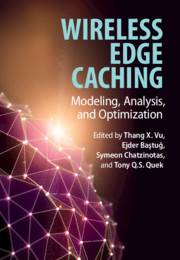Book contents
- Frontmatter
- Contents
- List of Contributors
- Preface
- 1 Introduction
- Part I Optimal Cache Placement and Delivery
- Part II Proactive Caching
- 7 Learning Popularity for Proactive Caching in Cellular Networks
- 8 Wireless Edge Caching for Mobile Social Networks
- 9 A Proactive and Big DataEnabled Caching Analysis Perspective
- 10 Mobility-Aware Caching in Cellular Networks
- Part III Cache-Aided Interference and Physical Layer Management
- Part IV Energy-Efficiency, Security, Economic, and Deployment
- Index
8 - Wireless Edge Caching for Mobile Social Networks
from Part II - Proactive Caching
Published online by Cambridge University Press: 19 October 2020
- Frontmatter
- Contents
- List of Contributors
- Preface
- 1 Introduction
- Part I Optimal Cache Placement and Delivery
- Part II Proactive Caching
- 7 Learning Popularity for Proactive Caching in Cellular Networks
- 8 Wireless Edge Caching for Mobile Social Networks
- 9 A Proactive and Big DataEnabled Caching Analysis Perspective
- 10 Mobility-Aware Caching in Cellular Networks
- Part III Cache-Aided Interference and Physical Layer Management
- Part IV Energy-Efficiency, Security, Economic, and Deployment
- Index
Summary
Wireless edge caching for mobile social networks (MSNs) has emerged as one of the prospective solutions to provide reliable and low-latency communication services for mobile users on social networking. In this chapter, we first give an overview of MSNs, including their development and challenges. We then discuss mobile edge caching (MEC) paradigms to address emerging issues for MSNs, e.g., service delay, users’ experience, and economic efficiency. In addition to the advantages, the development of MEC networks also places some key challenges’ such as hierarchical architecture of MEC networks, proactive caching, privacy, and security issues. The framework can authenticate MSN users based on public-key cryptography and predict their content demands utilizing a matrix factorization method. Based on the prediction, an optimal content caching policy for an MEC node is presented to minimize the average latency of all MSN users under the MEC nodes’ storage capacity constraints. Furthermore, this framework provides an optimal business model to maximize the revenue for MSN service providers based on the demands of the MSN users and the obtained optimal caching policy.
- Type
- Chapter
- Information
- Wireless Edge CachingModeling, Analysis, and Optimization, pp. 146 - 172Publisher: Cambridge University PressPrint publication year: 2021



